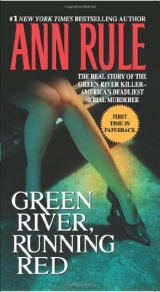
Текст книги "Green River, Running Red. The Real Story of the Green River Killer - America's Deadliest Serial Murderer"
Автор книги: Ann Rule
Жанр:
Маньяки
сообщить о нарушении
Текущая страница: 19 (всего у книги 37 страниц)
Barbara Kubik-Patten, who truly felt that she was getting messages from the dead girls telling her where fellow victims could be found, sensed that Mary Bridget, Kimi-Kai, Opal, and a blond girl she couldn’t identify were talking to her, and she was extremely frustrated that the task force detectives wouldn’t pay attention to her. The only investigator who had the patience to listen to her was Jim Doyon, whom Frank Adamson termed “a sweet guy.”
On April 15, 1984, Kubik-Patten tracked me down where I was having Sunday dinner at a friend’s house. I’d left the phone number on my answering machine in case my kids needed me. Like most of the task force detectives, I was growing weary of her insistence that she had psychic visions but that nobody would listen to her.
Impatient that she had interrupted my rare dinner out, I finally said, “You know, Barbara, your visions are too vague. I think you’re going to have to actually find a body yourself in order to convince them. Most detectives aren’t that impressed with psychics.”
I knew that she had been showing up at body sites and getting in the way of the investigative teams that were trying to gather evidence while they staved off the press and curious bystanders. On one occasion, Kubik-Patten and a woman friend had bulldozed their way into the woods near a body site search. They found the remains of an animal, which they believed was human, and poked at it. Unfortunately, they aroused a nest of yellow jackets. Her friend, who was allergic to bees, was stung and they had to flee in disarray.
The Wednesday after Kubik-Patten called me, a shovel operator on a crew of loggers found human bones in a deep woods owned by the Weyerhaeuser Company. They were scattered in a fifty-square-foot area off the north end of Highway 18, near North Bend, and in an area where two victims had been located two months earlier.
Dental records and the discovery of a mandible (lower jaw) brought quick identification. The bones were those of Amina Agisheff, thirty-seven, who had been waiting for a bus in downtown Seattle and was the first woman on the missing list. It was a surprising answer to the many questions about her disappearance. She had been the devoted mother of three children, someone never involved in prostitution.
Even though Amina’s remains were found close to earlier skeletons, her relatives could not believe that she fit the Green River victim profile, and neither did the detectives. She was too old, for one thing, and she had never been anything but a loving and responsible mother to her children. Her ethnic background was Russian, and she was part of an extended family who were always in touch with one another. Born in New York, schooled in Paris, she was a Montessori teacher and a waitress at the Old World Delicatessen in Ballard, the Scandinavian bastion in Seattle, far, far away from the SeaTac Strip. The thought that she might have been involved with prostitution was unfathomable to anyone who knew her. Whoever killed Amina may well have climbed on board the Green River Killer’s bandwagon deliberately.
Barbara Kubik-Patten, accompanied by her two youngest children, hurried to the area near North Bend the next noon. Barred by the yellow tape that marked off Wednesday’s search site, she entered the woods at a very similar spot a third of a mile away—also a gravel turnout from Highway 18—and began to search. She would say later that it was the voice of Kimi-Kai Pitsor that had told her to go there.
And she found a body.
Kubik-Patten rushed to where detectives were still processing the site where Amina Agisheff’s scattered skeleton had been found. She approached Rupe Lettich, one of the investigators who did not believe in her otherworldly messages, and tugged on his sleeve. He shooed her away, telling her she wasn’t supposed to wander onto the area being searched. She kept trying to get his attention, but Lettich had heard her cry wolf too many times. It wasn’t until Frank Adamson drove up that she found someone who would listen. He knew that she had searched for an entry into the woods that would match the Agisheff site. “She had to go quite a ways into a copse of alder trees from the pullout to find the body,” Adamson remembered. “The remains were covered with a green plastic garbage bag, and there were other bones of animals there. It was rather remarkable that she did find it.”
With Kubik-Patten’s discovery of this unknown victim on April 19, 1984, a strange coincidence, the investigation became even more inscrutable. The skeleton under the green garbage bag was not easily identified, and she became known, pathetically, as Bones #14. It was a long time before she would be identified as twenty-two-year-old Tina Marie Thompson. She was more streetwise than many of the girls who had been abducted, had brown hair and brown eyes, and looked a great deal like comedienne Carol Burnett. She had been tall and very slim.

BUT THERE WERE two Tinas. This Tina was not Tina Tomson aka Kim Nelson aka Star, the blond girl missing from the SeaTac Strip since the previous Halloween. She was still missing. Tina Marie Thompson had disappeared on July 26, 1983, and hadn’t been reported missing for some time.
Could the killer possibly have known that he had killed two young women whose names were so much alike? Probably not.
But still…
I had to admit to being chagrined that Kubik-Patten had actually found a body four days after I’d told her that that was what it was going to take to give her credibility with the Green River Task Force, never dreaming she would actually find one. It almost made me wonder if she had any guilty knowledge of the murders. The investigators must have felt the same way. They gave her a polygraph test, and she passed. They also reasoned that it wasn’t that amazing that she had stumbled across a victim. She had gone to the very next turnout where someone could pull off the road, and these turnouts were convenient for the killer; he had used them a lot. It might very well have been that deductive reasoning rather than ghostly voices had led her to pick a spot to search.
For several days, Barbara Kubik-Patten made headlines in Seattle papers, something she appeared to want for the previous two years. She explained to Mike Barber of the Post-Intelligencer that she had seen the Green River Killer twice.
Her first encounter had been, of course, at the Green River itself, where she saw the white car racing away. Now, almost two years later, she was able to give Barber a more precise description. She said she had heard a scream near the river and she and a male friend, whom she did not name, had seen the tall killer, but only in profile, as he walked across a clearing and got into a car. “He’s white,” she said firmly, “has brown hair, thin legs, and I’m not sure of his age, but he walks with a long stride—with long, slow-swinging arms.”
She even had a sketch artist draw a picture of how she pictured the killer in her mind. She recalled that his car was “souped-up.” She said she’d reached speeds of sixty miles an hour herself as she tried to catch his car, but he’d taken the curves like a professional driver. Where this driving feat took place is the question. Anyone driving that fast on Frager Road would surely have ended up in the river itself. The roads leading up the hill had such tight curves that nobody could go that fast without crashing.
Barbara Kubik-Patten announced that the Green River Killer was an “absolute genius” at getting rid of bodies, and she felt he had had some kind of special training that allowed him to outsmart the police crime lab. She also felt that the skeleton she found and that of Amina Agisheff held physical evidence that would allow the detectives to catch him.
Kubik-Patten believed she had vindicated herself, and she continued to show up at crime scenes and scan newspaper pictures of the victims so she could keep “in touch” with them more tightly.
This had been a compelling series of murders in terms of sheer numbers, and it was rapidly becoming more weird.
31
HE WAS ENJOYING the media coverage. He loved the attention, having been underrated all his life by most people, including his parents.
By the early eighties, he had been cuckolded by two wives—both “the skinny blonde and the fat brunette,” even though he had joked about changing his luck by choosing different types of women to court. He had learned about prostitutes when he was in the service, but they had also betrayed him by giving him a venereal disease. As one acquaintance described him later, “He didn’t seem like the sharpest knife in the drawer,” but he had learned a lot about social interaction. And he still had a robust sex drive, which required female partners. He’d been taught that masturbation was shameful.
He found a gold mine in an organization for divorced people with children, and he mined it skillfully. He dated a dozen or more women he met there. Darla Bryse* initially believed that meeting her new boyfriend at Parents Without Partners was serendipitous. In many ways, her life experiences were quite similar to the Green River Killer’s victims, just as they were much like those of his other girlfriends in PWP. She had suffered abuse and betrayal, but something in her still wanted to trust.
Born in Santa Rosa, California, to a housewife and a gas station owner–cum–construction worker, she remembered her childhood as being both loveless and frightening. “I was the oldest, and I knew I had two sisters,” she said, “but one went away. That’s about the only thing I remember before I was in first grade. My parents adopted my younger sister out to distant relatives.”
Although one of her grandmothers lived with them, Darla did most of the cooking and housework. Her parents had an active social life, belonging to lodges and clubs. They drank a good deal and had little time for parenting. “A man who was married to one of my mother’s friends abused me physically—sexually—and emotionally when I was very young,” Darla said. “I think my mother knew about it, but she never did anything.”
Darla never felt that she had much control over her life, although she acted out by being tough and starting a teenage gang. “I actually put razor blades in my hair,” she admitted. “But I was really just looking for someplace to belong, I think.”
Her first child was a boy, born out of wedlock. He was given to relatives. Darla wasn’t yet twenty when she married her first husband, Jimmy.* She was very much in love with him, and was thrilled when they married in January. She got pregnant right away and gave birth to a girl in October. She had another son within the following year. “I didn’t want to get pregnant again so soon,” she said. “I had two little kids under two and I had this compulsion about keeping my house absolutely clean, but Jimmy got drunk on Christmas Eve and even though I begged him not to, he just about raped me. And I knew right away that I’d be pregnant. I was.”
Darla couldn’t cope with three babies. When her baby son started screaming relentlessly one evening, she fought back a compulsion to throw him at the fireplace. “It was just luck that Jimmy came home early from work. I felt like I was out of my mind.”
She was suffering from postpartum depression, but it wasn’t an emotional disorder easily recognized in the sixties. Jimmy had her locked up in a state hospital for three months and quietly filed for divorce. “I was so naive and so dumb,” Darla recalled. “I didn’t want a divorce—I loved him—and I didn’t even know enough to get a lawyer. We were still going out once in a while and I thought we would be getting back together. And then my dad came to me and showed me a legal paper. Jimmy had been to court, and I didn’t even know that the divorce had gone that far. Jimmy got the house, the kids, everything….”
Jimmy began to date another woman and Darla couldn’t bear seeing them together. She left Santa Rosa and moved to Seattle with her sister. She was a very good-looking young woman and she got a job easily—as a dancer in a lesbian bar in the basement of the Smith Tower in Seattle’s Pioneer Square area. At that point in her life, she didn’t care about much of anything. “I learned about ‘Christmas trees’—dexadrine and blackberry flips,” she said of her introduction to drugs. “There was a gal who worked in the bar who got a crush on me, but I told her I wasn’t into that.”
Darla still missed Jimmy, and she went back to Santa Rosa as often as she could to visit her children, hoping that they could get back together. He seemed glad to see her and offered to rent an apartment for her. She visited her children, and sat by the phone in her apartment, waiting for Jimmy to come by. They were intimate again, and she believed that he still loved her. “I got pregnant again,” she remembered, shaking her head sadly. “I thought he’d be happy when I told him, but he said, ‘It’s not mine.’ And it was his. I hadn’t been with anyone but him.”
All of her life, Darla had been looking for love. Her ex-husband’s cruel response to what she thought would be joyful news threw her into the worst despair she had ever known. “I took Seconal and everything I could find that I’d bought over-the-counter, and I passed out, unconscious. I should have died, but my mother ran in unexpectedly. She was going to Mass and women had to cover their heads back then. She came to borrow a scarf from me, and she found me. And so my life was saved, and I was still pregnant. I thank God for that, now, because that baby girl is so important to me in my life.”
Because she had attempted suicide, Darla was once more committed to a state hospital. When she was finally released, she moved in with women friends, avoiding men for almost eight years. She had decided to put her baby girl up for adoption, feeling that she wasn’t an adequate mother. “But my best friend talked me out of it,” she said. “And we raised her together. I’m so grateful that I didn’t let Libby* go—she means the world to me.”
Darla moved back to Washington State and worked for the state and for public utility companies. She was an employment counselor for a while, and then an Avon Lady.
On her own again in her early thirties, Darla opted to have a tubal ligation. She had given birth to five children, and all but one were being raised by someone else. She wanted to date men again and she feared more pregnancies. Her sterilization gave her freedom she’d never had, and she went through a period of promiscuity. “I was drinking too much then, and I think I wanted to prove that I could satisfy a man, and I found that I could, even though I never had an orgasm myself. For the first time in my life, I was in charge in my relationships. It gave me a kind of power over men. I looked good, and they would just melt around me.”
Her flings with men lasted only six months, and she vowed to be a better mother to Libby. Her lifestyle changed dramatically from her days dancing in a lesbian bar and picking up men. Wanting a wholesome activity she could share with Libby, Darla joined Parents Without Partners in the late 1970s. She lived in West Seattle, and she attended group activities designed to help single mothers and fathers cope with parenthood and still maintain some kind of social life. Most of the group members lived in the south part of King County.
“We met in people’s homes for discussions, had potluck dinners, or went to dances at the Kent Commons,” Darla recalled. “Libby and I went on a lot of hikes and campouts with PWP. I was still drinking then, but we made a lot of friends and it was healthy for both of us to be exercising in the outdoors and up on the mountain trails. They were a good bunch of people.
“That’s where I met him—at Parents Without Partners.”
Darla had noticed the twice-divorced single father at other PWP functions and found him attractive, but he was living with another woman in the group. He had his son, seven-year-old Chad, on weekends and brought the boy to most of the picnics and hikes. He was obviously very proud of the little boy, who lived with his mother, Dana, during the week. He and Darla often signed up for the same activities where children were welcome so they could include Chad and twelve-year-old Libby.
One weekend, the group was hiking on trails in the Snoqualmie Pass foothills near Issaquah, and Darla found herself studying him. She thought he was quite good-looking, and muscular. He was about thirty, younger than she was by five years. “We found ourselves alone on the trail and we started talking. I found him very personable, and he was funny in a quiet way because he was pretty reserved. We both realized that we sort of hit it off, but he was still living with someone else so it wasn’t going to go anywhere.”
One evening that changed. “I started flirting with him, and he responded to me,” Darla remembered. “I came right out and let him know that I was interested in him. It wasn’t long before he broke up with the other gal. He moved out of her house, and moved right in with me. Just like that. That was in May 1981.”
He paid his share of the household expenses, and although he didn’t help her clean house, he did do yard work. Darla found him to be a very gentle man, although he wasn’t particularly sentimental. “I can’t remember that he ever brought me gifts, but I think he bought me a couple of cards.”
They didn’t have a lot in common. He never read books, and Darla was a reader, especially fascinated by true-crime books. She had read True Detective magazine from the time she was in junior high school. As far as she knew, he didn’t read them. He wasn’t interested in movies, but they watched television together in the evenings. Outside of PWP, he had very few friends, although he was close to one of his brothers. He often took Darla to visit his parents who lived a few blocks from Pac HiWay.
Although he had few interests, Darla found him to be an exceptional sexual partner. “I’d say his hobby was sex,” she recalled. “He wanted to make love at least three times a day.”
She didn’t object to that, although she was a bit embarrassed at first by his desire to have sex out of doors, in his car, or in places where they could easily be discovered. At the time, he was driving a burgundy truck with a white canopy, and he always kept a blanket in the cab in case they came upon an interesting trysting spot.
“I got so it didn’t bother me to have sex outside,” Darla said with a laugh. “One time we were camping near the Yakima River and we were making out on the bank and a canoe full of people came paddling by and saw us. They laughed and waved at us, and we waved back. By then, I felt so comfortable and so uninhibited with him that it didn’t faze me.”
Darla sometimes took his lunch to him where he worked. They often slipped into one of the huge semi trucks parked there to have sex in the cab’s sleeping area behind the driver’s seat. Nobody ever caught them.
He kept pushing the parameters of danger. He liked the Southcenter Mall area. Darla didn’t mind having sex in his truck in the Levitz Furniture Store parking lot, but she was very nervous when he told her he’d found a new spot. “There was this place where men were loading trucks at Southcenter,” she remembered. “There was a cement barrier, some kind of fence about ten feet long and fairly close to the ground. He insisted that we have sex on the grass right on the other side of that fence and I could hear the men working only a few feet away. They could have looked over and seen us, but he wasn’t worried about that.”
He was a passionate outdoorsman and he loved to camp and fish, although Darla couldn’t recall that he ever brought home any fish. Between them, they had collected all kinds of camping gear—tents, cooking grills, sleeping bags, and anything else they needed. Often, they camped for a week in the wilderness. Wearing nothing but a thin towel because he liked her naked, Darla cooked their meals on the outside stove.
Besides fishing, he liked to dig for old bottles alongside deserted railroad tracks. He drank very little and didn’t smoke. He seemed to her to be a perfect mate. “He was neat and clean and considerate. He was very, very muscular—very strong.”
They were completely open with each other in their discussions about sex, admitting fantasies they had. Both of them were experienced with any number of partners, although, as far as Darla knew, he was faithful to her while they lived together.
Once, when they were camping without their children in the Cle Elum wilderness in the Wenatchee National Forest, they agreed to try some bondage sex. Darla didn’t object to being tied to a tree or even to being “staked out” on the ground with her wrists and ankles bound, “as long as it was safe.”
He was excited about that, and even embroidered upon the basic concept by placing grapes and other fruit inside her vagina while she was helpless. They both found the innovative intercourse exciting, and he kept his promise not to hurt her. Theirs was certainly not an average relationship, but they were adults and it was nobody else’s business.
There were, however, aspects of this man that troubled Darla. He never told her he loved her in so many words. She would have liked that, but if she had to ask him to say it, it wouldn’t mean anything. More troubling for her, he wanted to go back to court and gain full-time custody of his son, Chad. “Chad was a good kid,” Darla said, “but he was hyperactive, and I didn’t think I could take having him around all the time.”
As her lover became more enthusiastic about getting custody of his son, Darla came to a decision. “I remember when I told him that I had to break up with him. It was close to Christmas in 1981. We were in our bedroom and I was sitting on the floor while he sat on the end of the bed. I told him that I could not emotionally handle raising Chad full time. I had four of my own children who weren’t with me, and I just couldn’t take on Chad.”
His head lifted and he stared at her, surprised. “And you never tell me you love me,” she added.
His eyes filled with tears. “But I do love you,” he said.
“I told him it was just too late to tell me at that point. He felt bad, I know, but he wasn’t angry. He moved out of my house and we broke up, but we were still friends.”
After he left, Darla’s daughter Libby told her that there was something about him that gave her “the willies.” She denied that he had ever molested her or said anything improper, but he had once come to her room to talk with her, and she just felt as if something was wrong. Darla was baffled; she had never known him to be anything but considerate and easy to get along with. She knew that Libby would have told her if he had made any untoward moves on her.
Early in 1982, he called Darla to say he’d bought himself a house in Des Moines, close to Pac HiWay. It was a small rambler. He was very proud of it, and he invited Darla and one of her girlfriends to a big housewarming party he was having. He’d also asked people he worked with and other PWP members.
“When we got there,” Darla said, “he had refreshments laid out and his house was all cleaned up. But no one else came to his party. I felt sorry for him, and we stayed and tried to pretend that nothing was wrong, but I could see he was hurt. He showed us through his house and his backyard. I remember there were two big fir trees out in his backyard. Every time I drove on I-5 after that, I could spot his house by looking up at those trees.” She recalled his backyard ended in a bank that dropped to the shoulder of I-5, the interstate freeway. The roar of the constant traffic on the freeway sounded like an ocean in a storm.
The only time Darla ever saw him show any anger was after their breakup. When his housewarming celebration was such a debacle, he invited her and Libby to dinner. She asked if Libby could bring a girlfriend, and he said that was okay. “Libby was just in her teens and you know how silly girls can be at that age,” Darla recalled. “For some reason she and her girlfriend got the giggles at the dinner table. I told them to settle down because he had gone to a lot of trouble to fix dinner for us, but they just had to look at each other and they giggled harder.
“Well, he got furious. He really lost it. I’d never seen him even get a little angry before. I don’t know if he thought they were laughing at him or what, but he shouted at them. He scared Libby. And we never went back to his house after that.”
It wasn’t long after that unfortunate dinner that Darla’s ex started dating another woman from PWP—Trish Long.* Darla heard a rumor about six months later that he had contracted the herpes virus and she considered herself lucky to have avoided that. Even so, she remembered him as a nice guy and wished him well. She had made some mistakes in her life, but she didn’t consider him to be one of them. Within five years, Darla met a man she would marry. She didn’t expect that she would hear much about her old boyfriend after 1981. They had begun to move in different worlds.








